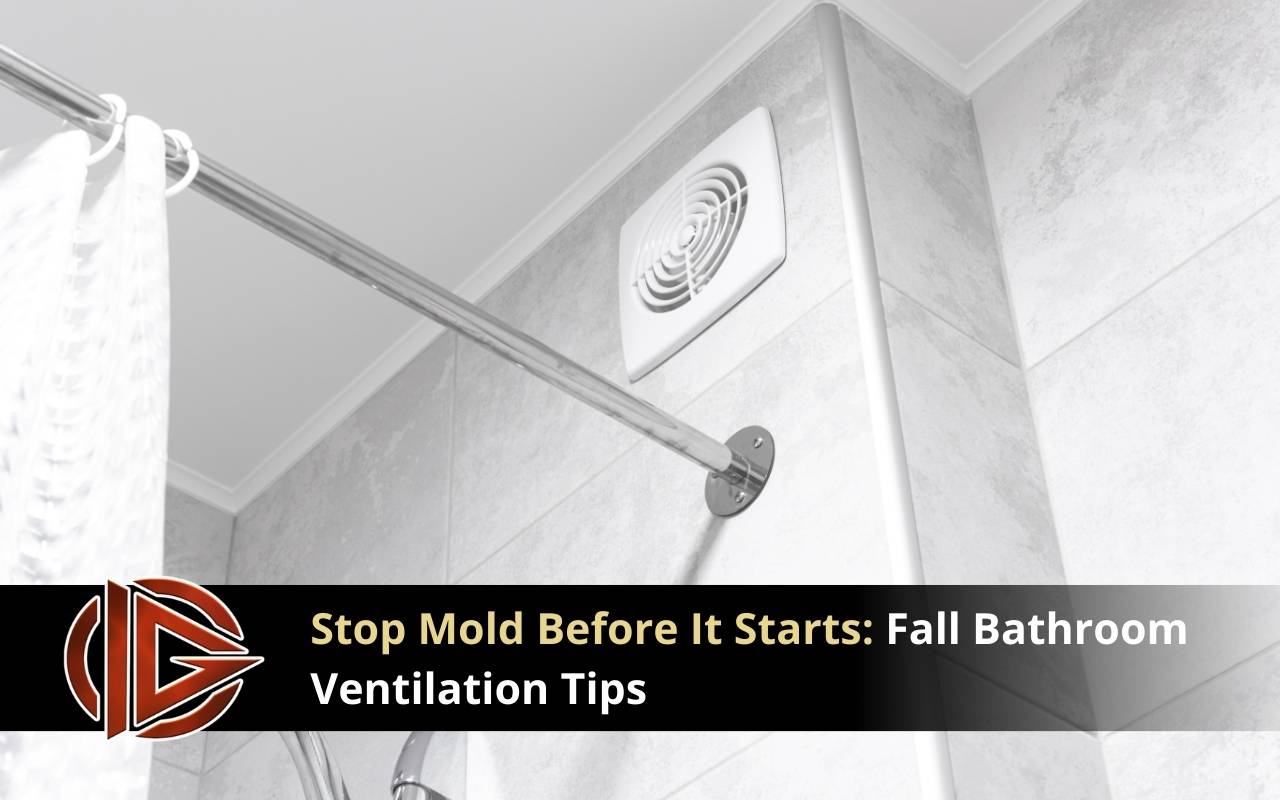
As the leaves turn and temperatures drop, our homes transform into cozy sanctuaries. However, the onset of fall brings more than just crisp air and pumpkin-flavored treats—it also ushers in the perfect conditions for mold to thrive. The increase in indoor humidity, combined with the frequent use of hot showers to fend off the autumn chill, can turn your bathroom into a breeding ground for this unwelcome guest. Ensuring proper bathroom ventilation fall humidity control is crucial in preventing mold growth, and understanding the intricacies of fall humidity control can save you from costly repairs and health issues down the line. Many homeowners underestimate the impact of fall’s unique climate on indoor air quality, often overlooking critical factors such as CFM sizing and duct runs. By integrating appropriate bathroom ventilation strategies, like installing humidity sensors or choosing between continuous and intermittent ventilation systems, you can maintain a healthy living environment. Waterproofing might seem like an added precaution, but it’s an essential step in safeguarding your home against mold-related damages. This season, take proactive measures to keep your bathroom free from mold—before it gets a chance to start.
Importance of Fall Bathroom Ventilation
As temperatures cool and homeowners seek warmth during fall, the bathroom becomes a sanctuary for hot showers and relaxing soaks. Yet this comfort comes at a cost—elevated moisture levels that linger long after the steam has cleared. Proper bathroom ventilation fall humidity control is vital to prevent condensation from building up on walls, fixtures, and ceilings. In the cooler months, humid air tends to settle in enclosed spaces, creating ideal conditions for mold and mildew. Without an effective exhaust system, tiny water droplets accumulate, feeding mold spores and compromising both indoor air quality and the structural integrity of your home.
Beyond structural concerns, poor ventilation can trigger health issues ranging from allergic reactions to respiratory problems. Mold spores released into the air are easy to inhale, especially in a confined bathroom environment. By investing in ventilation solutions tailored for fall humidity control, homeowners can reduce the risk of mold growth and keep indoor air fresh. Whether you choose an energy-efficient fan or a continuous exhaust system, acknowledging the importance of fall bathroom ventilation is your first defense against moisture-related damage and health hazards that may persist long after autumn has ended.
Understanding Fall Humidity Levels
Fall brings fluctuating outdoor humidity levels, often lower than summer but unpredictable when rains and storms arrive. Indoors, however, humidity can spike due to daily shower use, cooking, and even breathing. In bathrooms, a single 10-minute hot shower can release over a gallon of water vapor into the air. Without proper exhaust, this moisture condensates on cooler surfaces, creating a damp environment that encourages mold and mildew growth. Recognizing how fall weather patterns interact with indoor moisture sources is crucial for effective humidity management.
- Monitor humidity with a reliable RH reader.
- Maintain indoor humidity between 30–50 percent.
- Upgrade ventilation when levels exceed this range.
Choosing the Right Ventilation System
Selecting an optimal ventilation system involves careful consideration of fan capacity, fan type, and installation layout. CFM sizing is perhaps the most critical factor: the fan’s cubic feet per minute rating determines how quickly it can exchange moist bathroom air for fresh air. A general rule of thumb is 1 CFM per square foot of bathroom area, though features like high ceilings and multiple fixtures may necessitate higher ratings. Evaluating CFM needs ensures your system can handle peak moisture loads, especially during fall when hot showers are in high demand.
- Always calculate correct CFM sizing.
- Use short and straight duct runs.
- Install smooth-walled ducts for efficiency.
Integrating Humidity Sensors
Incorporating humidity sensors into your exhaust fan setup offers automatic control over moisture levels in the bathroom. These sensors detect relative humidity changes and activate the fan only when specific thresholds are reached, conserving energy when conditions are dry. This targeted approach ensures that your ventilation system works precisely when needed, maintaining consistent bathroom ventilation fall humidity control without unnecessary runtime.
Continuous vs. Intermittent Ventilation: Pros and Cons
Continuous ventilation provides a low-level, constant exchange of indoor air and outdoor air, running the exhaust fan at a quiet setting 24/7. This approach helps maintain a baseline humidity level, reducing the frequency of high-moisture spikes that occur after showers. Continuous systems are particularly useful in fall, when cooler air outside aids in maintaining balanced indoor humidity without drastic swings.
Intermittent ventilation activates the exhaust fan only when moisture levels increase or a timer switch is engaged. While this method can save energy, it relies on manual or sensor-based triggers to operate. Understanding the differences between continuous vs intermittent systems helps you choose the most efficient and user-friendly solution for your bathroom’s moisture management needs.
Waterproofing as a Preventative Measure
Applying waterproof coatings and sealants to vulnerable areas in your bathroom serves as an additional defense against moisture penetration. Waterproofing products, such as mold-resistant paint and tile sealant, create barriers that divert water back into drains rather than letting it seep into walls and subfloors. Investing in quality materials from the outset can prevent costly repairs due to rot and structural damage.
- Seal around bathtubs and sinks.
- Apply waterproof coatings in showers.
- Inspect tiles and grout regularly.
Tips for Reducing Indoor Humidity in Fall
Reducing indoor humidity goes beyond just running the exhaust fan. Keep windows or doors slightly ajar after showers to accelerate moisture dissipation when weather permits. Wipe down shower walls and doors with a squeegee to remove excess water before it evaporates into the air. Utilize moisture-absorbing products like silica gel packs or desiccant containers in small bathrooms with limited ventilation.
Maintaining a lower humidity baseline throughout your home also helps reduce moisture buildup in the bathroom. Operating a central dehumidifier or using portable units during particularly damp days can improve overall air quality. Proper bathroom ventilation fall humidity control is a combined effort of equipment, behavior, and routine maintenance.
Maintaining a Healthy Bathroom Environment in Fall
Regular cleaning and inspection are essential for a mold-free bathroom. Clean tiles, grout lines, and corners with mold-inhibiting cleaners at least once a month, focusing on areas where moisture lingers. Inspect ventilation fans for dust buildup and ensure the vents remain clear. Accumulated dust and debris can restrict airflow, undermining your system’s ability to manage fall humidity effectively.
Additionally, schedule professional maintenance checks for your ventilation system annually. A qualified technician can verify fan motor health, inspect duct runs for blockages, and test humidity sensors. Consistent upkeep not only prolongs the lifespan of your equipment but also ensures that your bathroom remains a safe, healthy space throughout autumn and beyond.
Common Mistakes to Avoid in Fall Bathroom Ventilation
One of the most frequent mistakes is undersizing the exhaust fan, neglecting proper CFM sizing to handle moisture loads. An underpowered fan may run continuously without effectively removing humid air, leading homeowners to believe the system is working when it’s not. Ensure you calculate ventilation needs based on bathroom dimensions and moisture sources to prevent this pitfall.
Another error is poor duct installation. Avoid flexible or kinked ducts that impede airflow. Proper duct runs with smooth, straight pathways are essential. Finally, don’t overlook the importance of humidity sensors—manual switches often get turned off or ignored. Automating your ventilation system with reliable sensors and combining it with waterproofing measures guarantees a more robust defense against mold in fall.
FAQs
How can bathroom ventilation prevent mold in fall?
Proper ventilation removes moisture before it condenses, ensuring bathroom ventilation fall humidity control protects surfaces and air quality.
What humidity level should I maintain indoors during fall?
Keep relative humidity between 30–50 percent to maintain comfort and reduce mold growth risks in bathrooms.
Are humidity sensors worth installing?
Yes, humidity sensors automate fan use, ensuring efficient bathroom ventilation fall humidity control while conserving energy.
Can waterproofing alone stop mold?
Waterproofing helps, but it must complement proper ventilation systems for complete protection against moisture problems.
How often should bathroom fans be maintained?
Clean and check fans every few months, and schedule professional maintenance annually for optimal performance.
Ensuring Mold-Free Bathrooms in the Fall
Effective bathroom ventilation fall humidity control requires a strategic approach that balances equipment performance with smart installation practices. By understanding fall humidity levels, selecting the right CFM sizing and managing duct runs, and integrating humidity sensors, you can create a system that addresses moisture at its source. Combining continuous vs intermittent ventilation methods with proper waterproofing offers multiple layers of protection against mold.
Implementing these techniques and avoiding common mistakes will not only safeguard your bathroom from mold but also enhance the overall air quality of your home. Take action this fall to keep your bathroom environment healthy and mold-free, ensuring comfort and safety throughout the season.




